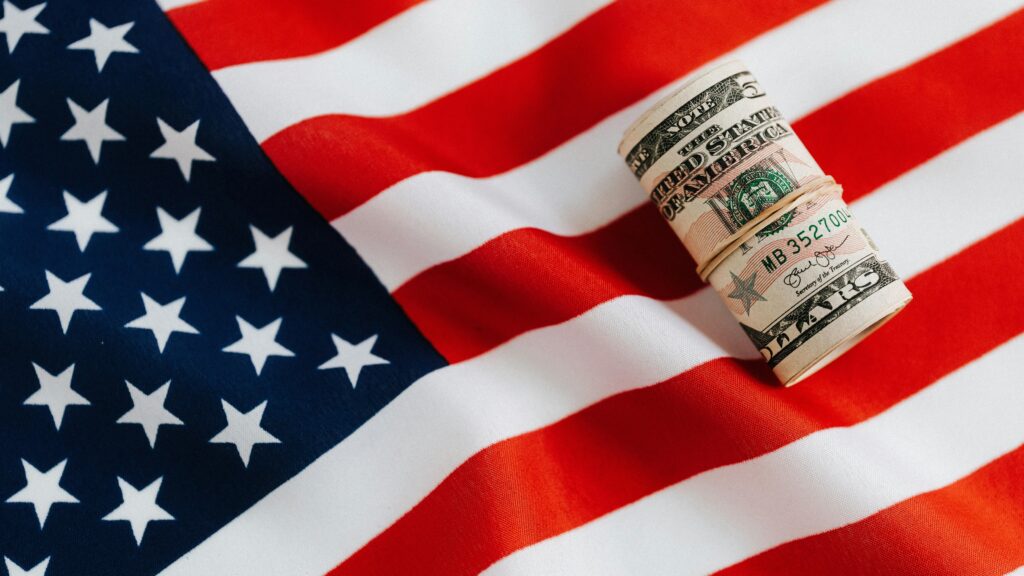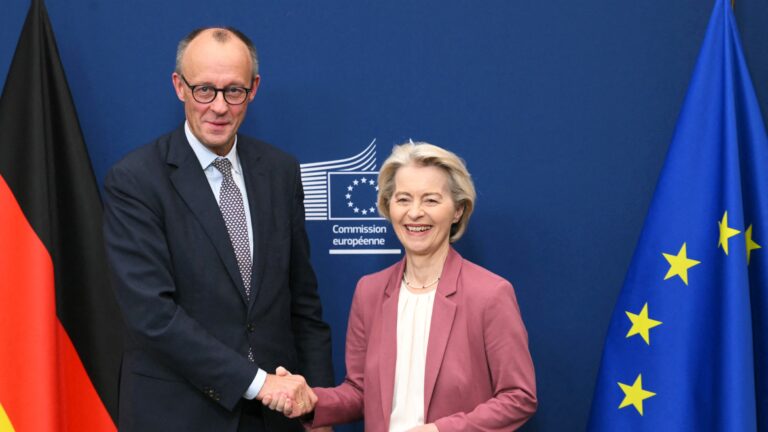Liberation Day was one of the most consequential days for the global economy since the end of the Cold War—perhaps even since the Second World War. Whatever comes of the trade war that has resulted, the phase of globalization that started after the collapse of the Berlin Wall has now definitively come to an end. There is no putting the genie back in the bottle. Even if President Trump and his advisors decided to slam trade policy into hard reverse and become born-again free traders, the effects of Liberation Day are now likely permanent. But what does this mean for Europe and Hungary?
No Going Back
First, it is worth understanding why the impact of Liberation Day is unlikely to be reversed. To understand this, we must understand what motivated the tariffs in the first place. The Trump administration is concerned about the large trade imbalances that the United States has been running for decades. In 2024 the American deficit with the rest of the world amounted to $1.13 trillion or 3.9 per cent of GDP. These large deficits are representative of the fact that Americans rely on production from other countries for their consumption—many goods are no longer ‘Made in America’.
Because Americans tend to buy products that are made abroad, there is less need for American manufacturing jobs. This accounts for the fact that many regions in the United States that were once manufacturing powerhouses with solid jobs for the local populations have been hollowed out. The extent to which these jobs have been lost to China alone is staggering. Studies show that rising imports from China into the United States between 1999 and 2011 led to the loss of between 2 and 2.4 million high-paid manufacturing jobs.
Liberation Day sought to rectify this situation by imposing large tariffs on these imported goods. These tariffs would, in theory at least, make the products more expensive, and this would lead companies to invest more in American manufacturing so that they could produce the products without being tariffed. This is why the Trump administration hopes that the tariffs will restore American manufacturing and ‘Make America Great Again’. The turmoil in markets that we have seen since Liberation Day is reflective of the fact that the system of globalized trade is perhaps more delicate than some in the White House thought. Understanding these delicacies allows us to have a deeper understanding of why the Liberation Day shock is unlikely to be reversed.
When a country runs a large trade deficit with another country, this means that they are importing more products than it is exporting. Imagine this as if I give you two apples and you give me four. I now run an ‘apples deficit’ with you. To balance this deficit, I give you an IOU. This is what countries do, too, except the IOU in question is money, and in the case of the United States, this IOU is US dollars. In our apple trade, you might accept the IOU once or maybe even twice, but if I come back day after day, trying to give you IOUs for apples, at some point, you will get tired of this and stop giving me apples. This is what should happen in international trade, too. If a country keeps issuing paper currency to another in exchange for goods and services, after a while, the value of that currency should start to decline. At this point, the goods and services from the exporting country become more expensive, and the importing country stops buying them.
‘If a country keeps issuing paper currency to another in exchange for goods and services, after a while, the value of that currency should start to decline’
But for decades, the United States has been able to run trade deficits with immunity. The rest of the world just keeps accepting the IOUs and never asks for actual goods and services in return. Why? Because the US dollar is—or, more accurately, was—the world’s reserve currency. Other countries want US dollars because they see them as a reliable way to ‘save’ money. But, since the US dollar is not backed by gold or anything else, this is ultimately a confidence trick. And like a confidence trick, the system only works so long as everyone maintains confidence in it. The moment confidence is gone; the system disintegrates.
This is what Liberation Day has done to the US dollar: it has made people nervous about holding it and, in doing so, robbed the US dollar of its reserve currency status. That is why the US dollar is falling in value. It is also why we see foreigners bail out of the American stock market and the market for US government debt. But if the goal is to close the trade deficit and bring jobs back home, this is not a bad thing per se. In fact, as some White House economic advisers have stated explicitly, the reserve status of the US dollar is the deep cause of the hollowing out of the American manufacturing economy. This reserve status was once called the ‘exorbitant privilege’ of the US dollar but has increasingly come to be viewed as an albatross around the neck of the American economy.
This is why the changes that Liberation Day has brought are very likely to be permanent: just as in the case of a confidence trick, once the ‘mark’ sees that the trick is indeed a trick, they will never believe in it again. The same is the case for the US dollar. Its credibility as a reserve currency is now permanently sullied, and so other countries will look for alternative ways to keep their savings. The fact that gold has reached $3,400 an ounce recently is no coincidence: what is bad for the dollar’s reserve status is good for gold.
Europe, Hungary and the Election
If these changes are indeed permanent, then what do they mean for Europe and Hungary? Let us take the case of Europe first. Europe’s top trading partner is the United States. In 2024 Europe imported €464.3 billion worth of goods and services from America and exported €536.4 billion, meaning that it ran a trade surplus of around €72.1 billion. The American export market, therefore, accounts for around 2.64 per cent of European GDP, and the trade surplus accounts for around 0.35 per cent of GDP. This is not an insignificant number. In an extreme case, if all exports from the EU to the United States were cut off in 2026, European GDP would contract by maybe 2.6–3.1 per cent. This would mean a significant recession.
But the goal of the United States is not to completely cut off all trade. Rather, America wants to rebalance its trade. That would mean eliminating the trade deficit. But as we have seen, the trade deficit is small relative to GDP. If this deficit were eliminated in 2026, the impact on European GDP growth would only be around 0.35–0.5 per cent. This is not an insignificant number, but it is tolerable. For this reason, it is in Europe’s interest to enter talks with the United States to try to rebalance trade in as orderly a manner as possible. It is not the rebalancing that threatens the European economy, so much as it is a disorderly trade war that sparks economic chaos in Europe itself.
‘America wants to rebalance its trade. That would mean eliminating the trade deficit’
Now let us look at the same figures for Hungary. Hungary currently exports around $7.66 billion worth of goods and services and imports $2.9 billion, meaning that the country runs a trade surplus of around $4.76 billion. It is worth noting that Hungary’s overall trade surplus is around $5 billion, meaning that if the United States rebalances its trade with Hungary, Hungary will no longer run a trade surplus. Rather, it will run a balanced trade. As we will see, this will mean lower growth for Hungary moving forward.
Overall exports to the United States from Hungary account for around 3.6 per cent of Hungary’s GDP. But more crucially, Hungary’s trade surplus with the United States accounts for 2.2 per cent of the country’s GDP. This means that if the United States forces a trade rebalancing with Hungary, Hungarian GDP growth could slow between 2.2–2.6 per cent. This would mean a severe recession for the country—and this recession would likely start to bite in 2026, an election year.
We are already seeing early signs of this rebalancing even without the impact of the tariffs. Since January of 2025, the forint has gone from 0.0025 forints per US dollar to 0.0028 forints per US dollar, an increase of around 12 per cent. This will hurt Hungarian exports to the United States. It is also worth noting that there are strong indications that the American economy might fall into recession in the coming year due to the Liberation Day shock. This would further weigh on Hungarian exports.
If Hungary wants to avoid a recession, it needs to offset this lost external demand with internal demand. That means the country must stimulate consumption, at least until it finds a new structure for its trade. In the long term, a stronger forint relative to the dollar will facilitate this. But in the short term, it would be wise for the government to undertake a modest spending programme. The easiest target here in the short term—that is, between now and the 2026 election would be a home-building policy for families.
The government should commit to allocating at least 1 per cent of GDP to homebuilding in the next year. This money should aim at building at least 50,000 new homes that are then sold to new families with a 37.5 per cent discount, with all the homes aimed at being built by the election next year. This should add roughly 1%–1.2% to domestic GDP growth and offset some of the downward pressure that will be exerted from the effects of Liberation Day. It will also align with Hungary’s pro-family strategy and
strongly incentivize family formation. In 2024 there were 77,500 children born in Hungary. If the homebuilding programme could be structured in such a way that it could encourage the birth of an additional 15,000 Hungarian children, the birth rate would increase nearly 20 per cent. In a separate piece in The Hungarian Conservative, I will lay out in detail how this plan, which will involve a lottery system for pregnant mothers, will maximize the use of housing as an incentive to raise the Hungarian birth rate.
A more ambitious programme allocating 1.5 per cent of GDP would be even better and would almost certainly insulate the country from the shock of Liberation Day in the run-up to the 2026 election. Properly structured, it could aim to raise Hungarian births by up to 30 per cent. Action is needed immediately. A simple boost to consumption by increasing support for families and other tax breaks is not enough to offset the potential shock that Liberation Day might have on the Hungarian economy. Only an ambitious homebuilding programme will have an effect that can be relied on to stimulate growth with confidence. If the government enlists the help of the private sector and lines up the incentives correctly, 50,000–75,000 homes can be built for families between now and the election in 2026. The crown is lying on the ground. Will the government be bold enough to pick it up? There is a strong argument to be made that a serious economic slowdown caused by the Liberation Day shock might be an electorally existential issue for Fidesz.
Related articles:







